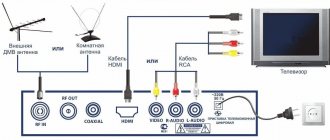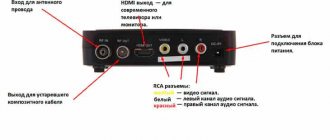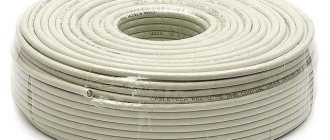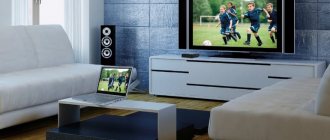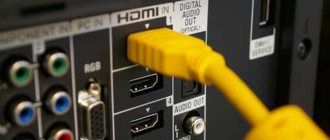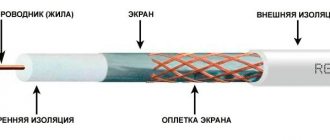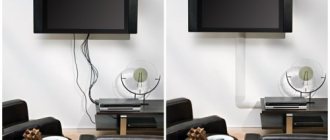Due to the transition to digital television in 2021, analogue broadcasting will be completely switched off. All owners of old TVs will need to buy a DVB-T2 set-top box to receive digital channels if their equipment does not have a built-in tuner.
What is digital terrestrial broadcasting in DVB T2 format
Digital broadcasting is a new way of transmitting audio and video signals by encoding this data in MPEG format.
Even budget modern TVs usually have a built-in digital tuner, and more expensive TVs add tuners for cable and satellite broadcasting.
Old TVs do not have a built-in tuner, and if the user wants to watch digital channels, the solution to the problem is to purchase a receiver.
Digital television standards
In Russia there is a European DVB frequency standard, which has several types:
- DVB-C and DVB-C2 - cable television broadcasting;
- DVB-S and DVB-S2 - satellite television broadcasting;
- DVB-T and DVB-T2 - terrestrial television broadcasting.
Broadcasting is available to every owner of a modern TV or TV receiver. To connect cable or satellite television, you must contact the provider that provides such a service.
What is a receiver
Digital television operates in a modern digital format. New technologies have improved sound and picture quality. In addition to 20 basic TV channels, digital catches more than 300 different TV programs and is constantly expanding its range.
Most older TVs, including LCD or plasma, are configured to work with an analog DTV (Digital Television) signal. It is transmitted in the AM band at FM radio frequencies. The transmission quality is low due to the large amount of interference. And the further the reception point is from the radio tower, the worse it is.
In order for the quality of television broadcasting to move from 525 lines, 60 fields and 30 frames to Full HD standards, you must connect the receiver to a TV.
Features of digital TV broadcasting
Analogue television operates using the standard DVB-C protocol. Digital broadcasting transmits signals in three ways:
- Satellite TV or DVB-S, S2;
- Cable – DVB-C;
- Broadcasting – DVB-
The equipment for decoding the signal is selected depending on its type. TVs with a built-in T2 receiver do not require auxiliary devices.
How tuners work
Based on the types of digital television transmission signals, there are three types of receivers: cable, terrestrial, satellite.
Regardless of the type, all tuners work on the same principle:
- Reception and amplification of a digital signal.
- Decoding and conversion to analog signal via RCA, SCART, HDMI, tulip connectors.
- Playing multimedia from USB media and drives (optional).
- Recording, stopping and delayed viewing (optional).
You need to connect the receiver to the TV specifically to “convert” a digital signal into an analog signal without losing the quality of sound and image.
TV repairs are 30% cheaper
than in service centers near your home
Order repairs
Which TV doesn't need a set-top box
Modern TV models are equipped with a built-in or external T2 tuner. For such options, no additional attachment is required. You can check the availability of such equipment in your TV on the manufacturer’s official website, for example, go to the Samsung website and type in the TV model in the appropriate section.
You can carefully study the passport for the TV. It must indicate the complete set and type of incoming television broadcast signals.
Smart TV, which operates over an Internet connection, does not require receivers. The quality of broadcasting in this case depends on the speed of data transmission over the network and the reliability of the connection to it.
What equipment do you need to buy?
If you don’t have a new TV with a built-in digital tuner, then you need to purchase a special set-top box. This device is a small portable DVB-T2 set-top box, to which a cable from an over-the-air antenna is connected via an antenna connector.
The user can also purchase a Smart TV receiver combined with a DVB-T2 tuner. In addition to watching television, you can connect to the Internet to watch movies online, listen to music, install applications, games, etc.
Receiver selection
When choosing a console, you need to pay attention to the following details:
- broadcast recording function;
- HD and Full HD support;
- presence of a control panel;
- connection interfaces;
- manufacturer country.
Attention! Regardless of the brand or other options, with a good signal level, any receiver shows 20 TV channels.
Common problems
The instructions discussed above give a complete understanding of how to turn on a TV with a set-top box on the remote control, how to connect and configure the equipment. But during the viewing process, problems may arise that require prompt action. Let's consider several situations:
- You are unable to receive channels. To solve the problem, check the quality of the cable connection to the antenna and tuner, and make sure that it is intact. Pay attention to the orientation of the receiver and try changing its position. Also learn that to receive a digital signal you need to connect a special antenna. If you use an older type device, it will only receive an analog signal. Also check the characteristics of the set-top box - it must accept DVB-T2.
- Can't find all channels. In such circumstances, check which TV channels you can catch in your area. To do this, use the interactive map of CETV and look at the necessary data. The cause may also be receiver errors, so the best solution is to reconfigure the digital television set-top box from scratch.
- Bad signal. A common situation is when the received signal is too weak, causing the picture quality to suffer. In such a situation, do the following - buy an antenna with an amplifier and change its location. If the problem is caused by a satellite dish, weather conditions may be the cause. In this case, you just need to wait for the weather to improve.
- No signal. A common situation is when you managed to connect the equipment, but a message about no signal appears on the TV screen. Check the cable and antenna. If there are no complaints about them, contact the provider and clarify whether any work is being done or not.
- The picture slows down or freezes. To solve the problem, try updating the software or reflash the hardware using the wizard. If bad weather is the cause, wait it out and watch analogue TV. Knowing how to switch your TV to a set-top box, you can return to digital channels at any time.
In conclusion, we note one more situation when the channels suddenly disappeared. In this case, don't panic. Perhaps there is technical work going on and you just need to wait. If these are not carried out, check the serviceability of the antenna, wire and set-top box. If the tuner breaks down, take it for repair.
Standard equipment for digital set-top box
Typically, a standard receiver kit includes:
- instructions;
- RCA or HDMI cable;
- the console itself;
- cardboard box packaging;
- remote control;
- batteries for the remote control;
- power supply (network adapter);
- warranty card.
Options for connecting an old TV to digital
Let us immediately note that when we say the word “old,” we of course mean TV models that were released at least this decade or since the early 2000s. Tube models will not fit here (this is not a joke) and of course it is better to change them.
In order for your TV to receive a digital signal and decrypt it as needed, it must be able to work with the DVB-T standard. This can be done by connecting an additional set-top box to it.
They are manufactured under various brands and differ only in additional sets of functions, for example, playback of certain formats on a flash drive. However, even the simplest models will easily perform their main function. Therefore, you don’t have to spend money here.
Visually, the connectors for most digital set-top boxes look like this:
In this case, we are interested in the antenna connectors and tulips. HDMI is only found on modern computer models and monitors, so we won’t touch on it. All manipulations will occur through multi-colored connectors called tulips. They look like this:
Tulip type connectors
You need to connect them by color. In this case, the wire itself will have 3 plugs on both sides. They must be connected by color. The TV must have the same connector as the set-top box. If it is not there, then there must be an input for SCART. It looks like this:
SCART connector on TV
In this case, you will need a special Scart-Tulip adapter so that you can use the usual tulips from the set-top box, while connecting everything to the Scart connector of the TV. It looks like this:
Scart to tulip adapter for TV
After everything is prepared, you can start connecting.
Read also: How to solder aluminum wires at home
Connectors and their purpose
Depending on the year of manufacture of the TV, the connectors on it may differ. The following types are used to connect the set-top box:
- Antenna connector. It was used to connect an analog antenna, now digital broadcasting is received through it.
- RCA (Tulip). This is the most common method of connecting a tuner to a TV. Although the quality of the video stream is lower than with an HDMI connection, on small screens the difference is almost unnoticeable.
- HDMI. The most modern and significant connector, capable of simultaneously transmitting digital video and audio.
- Scart. Can connect legacy devices to more modern equipment, used if other ports are not available.
- VGA. Provides video transmission, also useful for older equipment that does not have an HDMI input.
RF interface
The RF type interface allows you to connect not only satellite broadcasting, but also cable television. The quality of transmission through this output does not have a good picture, so watching TV shows in high definition has the mesh ripples already familiar from “tulips”, as well as a problem with large diagonals of devices.
One of the main advantages of such an interface is the ability to connect the receiver to a second TV. The only condition that must be strictly observed is the presence in the set-top box of a high-frequency RF modulator and a corresponding output. But not all TV set-top boxes have such components. So keep this nuance in mind before connecting the Tricolor receiver to your TV, because many devices from this provider do not have this technical capability.
Read also: What is the difference between a two-stroke and a four-stroke engine
How to properly connect a digital set-top box to your TV
Attention! Before connecting, make sure that the devices are disconnected from the power supply.
The receiver is connected as follows:
- Check the availability of analog (RCA, D-SUB or SCART) or digital (HDMI, DVI) connectors and cables and select the appropriate one.
- Remove the film from the receiver, install it in the chosen location and connect it to the TV.
- Connect the set-top box to power.
- Connect an indoor or outdoor antenna to the antenna input (you should choose the latter option if you live more than 15 km from the tower).
- Turn on the tuner and TV, proceed to the broadcast settings.
Connection diagram
The connection algorithm depends on the selected cables:
- To connect RCA “tulips”, connect the connectors of the devices with a cable, based on their color markings. The yellow cable transmits video, while the white and red cable transmits audio.
- HDMI-HDMI or SCART-SCART cables also plug into their sockets.
- When connecting via the antenna input, you need to connect the antenna to the set-top box by inserting the cable into the RF IN port, and connect the cable from RF OUT to the TV.
How to connect two or more TVs to a set-top box?
Several devices can be connected to one tuner via the antenna jack. For this you need a so-called splitter.
Important! All connected TV receivers will work synchronously, that is, show the same channel at the same time (after all, there is only one set-top box).
You can also connect two devices to one receiver using free interfaces. For example, connect one TV via RCA, and another via HDMI.
Connecting to an old TV
Connecting the set-top box to an older model TV can be done in three ways:
- via a SCART connector by purchasing a tuner with a similar output;
- via AV input with RCA-RCA cord (tulips);
- To a very old television receiver equipped only with a radio frequency antenna connector, you can connect the receiver using a high-frequency modulator.
Signal quality
You can count dozens of nuances that are responsible for the quality of the decoded image. Here is the original signal from the satellite that the receiver receives, the technical capabilities of the device’s interface unit, the type of cable used, and much more.
You need to choose the interface of a TV set-top box very carefully, taking into account not only the capabilities of your TV, but also the future provider, the type of satellite dish, and even the weather conditions of your region.
So, how to connect a TV to a receiver: interfaces, methods and additional equipment.
Broadcast settings
Each receiver model has its own interface, but in general you should adhere to the following steps:
- Press the "Menu" button on the remote control.
- Select Settings or Options.
- Select the signal standard. In this case, digital broadcasting requires the DVB-T2 standard.
- Go to the “Auto search” item and wait for the TV to find all available channels.
Reference! If in automatic mode the tuner found few channels or did not find them at all, then you need to go to the menu again and instead of “Auto search” select “Manual tuning”.
Summarizing
Before buying something as expensive as a receiver, be sure to check whether your TV has certain outputs. If you have a new model, then it is probably equipped with an HDMI interface, which means there will be no problems with the connection, as well as with image quality.
In second place are the component “tulips” for analog and digital signals – YPbPr and YCbCr. Slightly worse than HDMI in terms of connection, but nevertheless the output picture is pleasing to the eye in the same high Full HD quality.
The third and fourth places go to the SCART and S-Video interfaces. The main thing here is not to overdo it with the screen diagonal, otherwise small ripples will be noticeable in high-resolution pictures.
The fifth and sixth positions went to the RF and RCA (“tulip”) connectors. The quality of the decoded signal on these interfaces is noticeably lower than that of others: low audio bitrate, slightly “blurry” picture and the finickiness of connectors for certain TV models.
You should also remember that before connecting the set-top box to the TV, you need to follow the following rules:
- Be sure to unplug all devices from the electrical outlet when connecting.
- Carefully study the manual, especially the “Connection” section.
- Based on the second point, strictly follow the sequence of actions performed.
- Use normal cables (branded RG-6), not Chinese thin fakes.
- There is no need to use long cables as this directly affects image stability.
After you have connected the receiver, it would be a good idea to double-check everything (whether the cables are tight, markings, etc.), and only then turn on the equipment.
For some TV viewers, the transition to digital will mean the purchase of new equipment. Unfortunately, outdated TV models that do not support the DVB-T standard will no longer be able to receive television broadcasts; they are simply not suitable for this. Retail outlets are already starting to persuade people to buy a new TV, but we strongly recommend that you think twice. If it works and suits you to the fullest, then most likely you can simply buy a digital set-top box for it.
It costs several times less (from 700 rubles) and works just as well. The most important thing here is to be able to configure channels and correctly connect the device using the available connectors. By the way, we’ll talk about them today.
The most common connection problems
Users often encounter the following problems:
- Rippling image. In some cases, squares can be observed. Solution - make sure that the cable is in good condition, that the antenna is correctly connected and positioned, because the reason lies in a bad signal.
- Colorless picture (black and white). Check that the cables are connected correctly. You may have mixed up the connectors. Have you checked the connection and everything is ok? Go to the tuner settings and in the “Image” tab, select “Auto-tune”.


